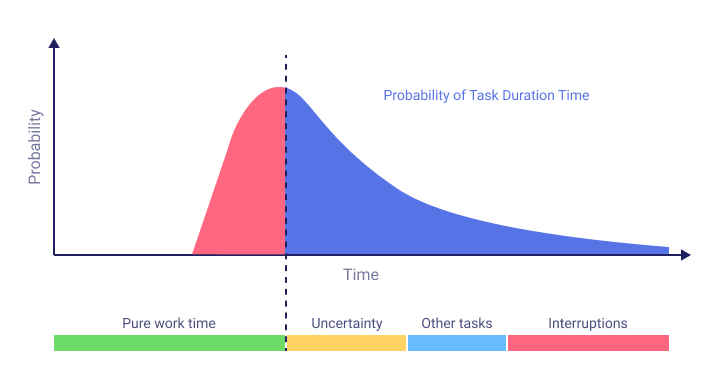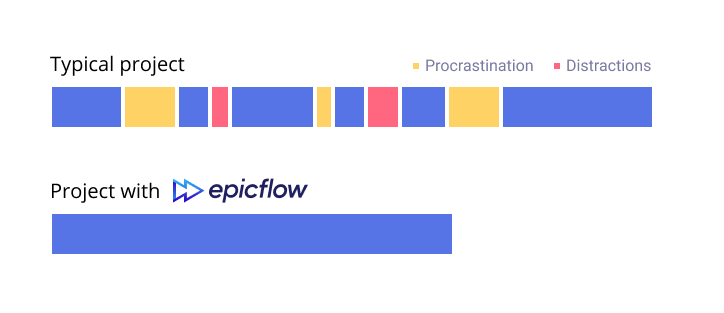Everyone engaged in project management is aware that this field is prone to different kinds of uncertainties. They all are diverse and unpredictable, though there are some that appear in every project due to their nature. Parkinson’s law is an example. Any project is sensitive to it because this phenomenon originates from human behavior, and projects are executed by people. So, let’s consider its essence, how it affects your project due dates, and try to find the best solution to deal with it to eliminate its harmful effects on your outcome.
What is Parkinson’s Law?
The phenomenon of Parkinson’s law is derived from the article published in the Economist in 1955 by Cyril Northcote Parkinson. Actually, the main idea of this law lies in the first sentence of the essay: “Work expands to fill the time available for its completion”. Later the author wrote some books that became quite famous in the world where he described his bureaucracy observations as a British civil servant and further developed his ideas on what’s now called Parkinson’s law. And despite the adage being used in a different context, project managers consider Parkinson’s law as a potential constraint to their projects.
Why Does Parkinson’s Law Effect Appear and How Does It Work?
As a rule, Parkinson’s Law arises when too much time is allotted for completing a task. Usually, time estimates are exaggerated in order to cover Murphy’s Law (If something can go wrong it will go wrong). But when we put too much safety into a task’s duration it becomes prone to uncertainties. The more time is given for task completion, the more time is wasted. Parkinson’s Law may affect both time and budget.
Parkinson’s Law in Project Management: Project Duration Affected

Let’s consider some Parkinson’s law examples. Let’s say it’s Monday and you have a week to complete a task that you can really finish within 2 days. It will take you a week to complete it anyway if you know you have this time. It sounds strange but it really happens due to the human nature. And be honest, when will you start working on this task? Most people would start on Thursday because procrastination is a tendency of people. That’s called the Student Syndrome. Since we don’t live in an ideal world we will find out at the latest moment that we need more than these two days… And with this Parkinson’s law example, we’ve just proven that Parkinson’s law of time exists.
- Parkinson’s law pmp can manifest itself in a tendency to complicate easy things. It can be explained like this: when you’re short of time you focus on the core of the problem and resolve the task immediately. And when you know you have plenty of time time you start paying more attention to details which takes extra time and pulls you away from the very essence of the issue you’re working on. Therefore, the more time we spend on the task, the more complex it seems, which ruins productivity as a result.
- In the context of dependent employment, Parkinson’s law can be also explained by the fear of the employer’s higher expectations. Despite the fact a worker can complete a task earlier, they will never report on it. Otherwise, next time their employer will give them less time to finish a similar task or increase the assignment of tasks.
- Besides, even a simple task can be postponed by different kinds of interruptions: meetings, calls, sudden tasks, etc. An employee pays a lot of attention to arising challenges and activities trying to resolve them, and when coming closer to the deadline they realize they weren’t that important, and the time was wasted on the tasks with lower priorities. As a result, the time of task execution becomes unnecessarily long.
Parkinson’s Law in Project Management: Project Budget Affected
Parkinson’s Law may refer not only to time issues but also to budget limits. It implies that when you’re working within a certain budget, you will probably spend all the money rather than save something. This can be explained by the fact that an employee is afraid of not getting the necessary budget after saving a part of the available sum. On the other hand, it also can be referred to as psychology: the more money we have the more we spend.
How Parkinson’s Law Time Management Affects Your Project Due Dates and Profit
- If you schedule a project by defining strict start and end dates of the tasks allocating too much time for each one, you won’t probably succeed in your business because too long lead time increases expenses and besides, you won’t ever satisfy market demands.
You would probably want your employees to speed up in executing their duties without getting interrupted and wasting time for unnecessary ‘polishing’ and of course to report if they complete their tasks before the deadline to have some safety time, but it won’t ever happen due to Parkinson’s Law. Thus, it always negatively affects your project due dates. Therefore, you should have a plan on how to reduce its effect on your projects or eliminate it at all.
- Similar things happen to your budget: all the allotted money will be spent during the project execution even if it’s not necessary. Hardly anyone will save your money on their initiative. As a result, you’ll spend more on the project than you could due to Parkinson’s Law.
Parkinson’s Law of Triviality
The law of triviality, introduced by C. Northcote Parkinson in 1957, suggests that members of an organization often focus disproportionately on minor issues while neglecting more significant, complex matters. It presents another challenge in project management, especially in multi-project environments with a shared resource pool, where capacity is limited and resource performance must be maximized. The good news is that the tips we suggest below work for both laws and will bring you the desired results in no time.
Tips to Overcome Parkinson’s Law Explained

When your team is working on a project and every member has their individual tasks with estimated durations, your project due dates are dependent on these people’s efficiency. Apart from a number of unexpectable uncertainties your project may face on its way to the goal that you can’t predict, Parkinson’s Law effect is that you can be ready for and even prevent it.
Task Duration Estimates VS Work Estimates
Setting optimal task completion times is a common recommendation in project management literature. Estimating a task is a rather difficult process because it depends on a lot of factors, e.g. whether it’s a new kind of activity or your team members have done it millions of times before, whether it’s going to be performed by a highly-qualified employee or the one without a necessary experience, etc. So, when setting up a task duration, one has to take all the necessary information into consideration. As a rule, when estimating a task’s duration one puts some safety in it and gives it about 80-90% probability, but what happens is the task execution becomes unnecessarily long and prone to a lot of harmful effects.
The more probability you put into a task duration the more vulnerable to Parkinson’s Law and the above-mentioned Student Syndrome it becomes as the time period for task execution becomes longer due to uncertainties, interruptions, and things like that, as shown in the picture below.

“Believing in estimated task durations is the main source of Parkinson’s Law”. Albert Ponsteen
Let’s consider some tips for estimating time and the amount of work a task takes:
- Just imagine yourself being asked how long it will take to complete a difficult task. You’ll definitely be confused because you don’t know all circumstances and probable interruptions, you don’t know how simply you’ll cope with arising difficulties, how much extra current tasks you’ll have, and so on. This is especially relevant for a multi-project environment when you work for several projects at the same time, and urgent tasks can appear at any time. It’s 100x easier to estimate how much work a task takes than to estimate its duration.
- It’s much easier to answer a question of how much work a task takes, and the answer will be definitely more accurate because you can list the steps the task needs to be completed, even if it’s a new one you’ve never done before, as you can divide it into smaller parts.
Therefore, what’s really important is the amount of work and effort an employee puts into task completion, not its duration. You have to stop believing these estimations, it is the prime cause of Parkinson’s Law.
“Time estimates are probabilistic. The mistake we make is we treat them as deterministic”. Dr. E.M. Goldratt
In Epicflow, we take into account only physical durations, like drying time, ordering time, duration test time, etc. Only this kind of duration is relatively reliable, accurate, and thus, significant. Let’s consider some ways we can help you beat Parkinson’s Law and protect your projects.
Forget about Parkinson’s Law and Deliver Your Projects Twice as Fast with Epicflow

Employee Level
-
Use priorities and work estimates
In Epicflow, we reduce Parkinson’s law effect by prioritizing tasks based on the amount of work they take and their order (dependent tasks) instead of measuring duration of task and establishing start and end dates for them. Setting realistic time estimates is effective but understanding the scope of work is more accurate.
-
Be guided by the basic rule: finish the task with the highest priority ASAP
Thanks to priorities, you know what task should be finished asap. Stop all lengthy discussions about the time a task must be finished. Work on the task with the highest priority and report on its completion as soon as possible, and enjoy the results of shorter task duration.
-
Eliminate bad multitasking
Clear priorities kill bad multitasking. When you’re aware of project tasks’ priorities, you won’t ever switch to something else, simply because you know what’s really important at the moment.
-
Leave the project in a better state than when you started working on it
Remember to save a buffer for someone else, don’t waste it. Focus on a simple rule: as you start working on a task the priority shouldn’t increase.
In such a way, we make our projects less vulnerable to uncertainty, Parkinson’s Law effect, and Student Syndrome at the employee level.
Project Management Level
-
Eliminate task deadlines
Based on our experience, we know we can beat Parkinson’s Law effect by eliminating due dates for tasks and setting up clear priorities.
In such a way, your team members will work on the issues from the higher to lower priority and report on their task competition at once, without waiting for the established due date. We set up only intermediate milestones to protect key deliveries. Even realistic deadlines aren’t accurate enough, and if you want to overcome Parkinson’s law effect, you should better forget about them. The absence of task deadlines will help your teams work at their pace and increase personal productivity.
“It is not important to finish each task on time. It is essential to finish each project on time!” Dr. E.M. Goldratt
This statement of Goldratt was a bit too harsh and many of Epicflow’s customers could not live with only one milestone. Therefore, Epicflow supports intermediate milestones but related to key dates, that if they get in danger, the whole management team will take massive action.
You can get all the necessary information about multiple projects and their milestones in Pipeline.
-
Apply project buffer
One more way to avoid Parkinson’s Law effect that is actively used in Epicflow is to protect your project due date instead of protecting every task by applying a project buffer. Similar to the Student Syndrome effect eliminating techniques, the joint buffer will prevent your team members from procrastinating and wasting project time within their individual tasks. It’s also a good way to protect yourself from Murphy’s law which helps support a project schedule and deliver on time.
-
Track project buffer
All necessary information about the project buffer is reflected in task priorities, and the evolution of the buffer state over time is clearly displayed in Dashboard.
Read more: Bubble Graph: Critical Chain Fever Chart Re-Imagined.
Resource Management Level
-
Track progress
As has been mentioned by Dr. Goldratt in his novel “The Goal”, activating and utilizing a resource are not synonyms.
“Utilizing” a resource means making use of the resource in a way that moves the system toward the goal. “Activating” a resource is like pressing the ON switch of a machine; it runs whether or not there is any benefit to be derived from the work it’s doing.” ― Eliyahu M. Goldratt, The Goal.
It means that instead of tracking all hours worked by an employee, keep an eye on and record their efficiency during the working day as any worker regardless of their qualification cannot be productive all 8 hours a day.
You can easily do this using PM tools. For instance,
- Tasklist gives you an opportunity to review your team members’ tasks, their status, and progress.
- With Task Card, you can get all the necessary data about a certain task.
- Timesheet provides you with a clear idea of what your employees are working on at the moment.
Besides, performance analysis includes considering your employees’ previous results, which is an essential KPI coefficient in a multi-project environment. In a Historical Load Graph, you can check out the progress on the right tasks and the number of man-hours you have spent against the baseline.
Read more: 5 Ways Epicflow Enables High-Performing Teams
Saving Your Budget
All the above-mentioned recommendations will also help you protect your profit from Parkinson’s Law. You can easily control your budget on the Dashboard menu in Epicflow. And Bubble Graph is a convenient way to control your project and budget buffers.
If you beat Parkinson’s Law, you can deliver your projects 30-60% faster and save up to 20% of your budget. How do we know that? From evidence. A Dutch telecommunications company KPN has improved its efficiency by 21%, and their delivery reliability increased by 62% thanks to Epicflow. Besides, their lead-time has reduced by 50%.
Isn’t it a great motivation to change the way you manage your projects and choose a reliable solution to run your multiple projects effectively? Epicflow team is always here to tell you more about our approach and tool, don’t hesitate to contact us and book a demo.
FQAs
What is Parkinson’s law of time management?
Parkinson’s law states that work expands to fill the time given to complete the task. In other words, a resource will spend twice as much time doing the easiest task simply because they have this time.
Why is it important to overcome Parkinson’s law in project management?
It’s critical to overcome Parkinson’s law in project management as it hinders resource performance by making task durations longer, and therefore, increases the risk of project delays. If predecessor tasks take too much time and are delayed, the successor ones get delayed, too, which results in missed project due dates. It can also affect the project budget and result in a cost overrun.
How to overcome Parkinson’s law in project management?
- Use priorities and task estimates.
- Don’t be focused on task deadlines, eliminate them.
- Finish high-priority tasks as soon as possible.
- Eliminate bad multitasking.
- Apply and track project buffer.
- Track resource performance together with project progress.

